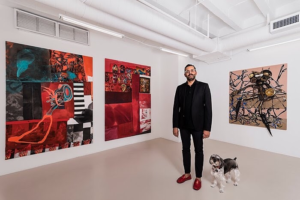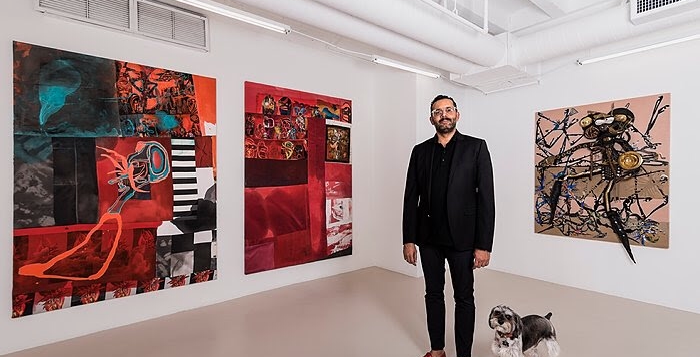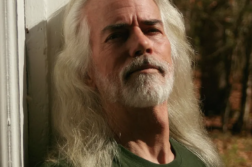IN THE 1960s, David Castillo’s parents, like many other Cubans, were faced with remaining in Cuba during Fidel Castro’s turbulent revolution and losing everything or starting over elsewhere. They headed for Spain, where David was later born, in 1973. Four months after that, they moved to Hialeah, Florida.
I grew up in Coral Gables and Coconut Grove knowing the slums of Overtown, Liberty City, and the shabby Wyndwood district along 36th Street and the FEC railroad yard, which had gone bust. Having been an art critic and teacher in Miami in the 1970s, I played a small part in the emerging Miami art scene, so what impressed me about Castillo’s gallery was his vision for reshaping that scene.

Castillo graduated as valedictorian from Hialeah High School and went on to live for a time with his aunt in Madrid. He applied to Yale and was accepted. Once in residence, he received a welcome letter from the administration that began: “Dear person of color.” Today, one can’t imagine any institution sending such a letter underscoring his status as a token minority. Shocked but undaunted, he went on to earn degrees in history and art history at Yale, where his thesis focused on early issues of the Advocate and other gay publications. Castillo spent a lot of time at the American Decorative Arts area in Yale’s art museum and in curatorial departments. He later undertook independent studies at the Angelicum in Rome.
Castillo returned to Miami in the late 1990s and took a job at the Miami Art Museum (now PAMM), where he befriended a number of artists. He reveled in the particular pleasure of finding cutting-edge artists whose work reflected the Caribbean and Latin cultures in which he had grown up. His eyes were wide open for new opportunities, and he had a passion for contemporary art. In 2005, he became one of the pioneers who revitalized the Wyndwood (now Wynwood) district to make it what it is today. Over thirteen years have passed since he opened his own art gallery there. He turned a warehouse into a 5,000-square-foot exhibition space with a focus on conceptual curatorial models as they relate to art historical, cultural, and personal investigations of identity.
This is not to say that it was an easy transition into fame and fortune. In 2009, having struggled for several years to put the gallery on firm financial ground, he was hit by the economic meltdown of the Great Recession. There were days when he didn’t have enough money to eat lunch and struggled to pay the rent. But he had personal grit and the support of both his artists and his collectors, and together they weathered the storm. Today, David Castillo Gallery, has relocated to Miami Beach’s famous Lincoln Road.
From the outset, Castillo has nurtured unknown young artists early in their careers, and he has stayed with them through thick and thin. His dedication to women artists, artists of color, and LGBT artists led him to showcase such local artists as Adler Guerrier and Pepe Mar as well as international artists such as Sanford Biggers, Kate Gilmore, Lyle Ashton Harris, Jillian Mayer, Robert Melee, Xaviera Simmons, Shinique Smith, and Wendy White. Castillo has curated a succession of amazing special exhibitions, often taking considerable risks to give non-mainstream and outsider artists a platform. This willingness to develop promising artists has enabled him at age 44 to leapfrog to the top of the art world.
In this year’s edition of Art/Basel–Miami Beach, the David Castillo Gallery has for the first time claimed a space in the fair’s top tier, making it only the second Miami-based gallery to do so. Art/Basel, for those unfamiliar with it, is one of the international art world’s most prestigious events, bringing together the world’s leading galleries and showing works by over 4,000 artists. Being selected for excellence by a jury of international art experts is no mean feat for an upstart gay immigrant based in Miami.
To date, Castillo has produced more than 116 exhibitions representing a core group of younger artists that includes Joe Bradley, Michael Williams, and LaToya Ruby Frazier. Many of his artists present utopian or dystopian fantasies that boldly defy compulsory heterosexuality, presenting an entirely new world of possibilities. The art that most interests Castillo and his collectors grapples with the whole history of deceits and failures, loss and pain, of truths unseen, unremarked, and suppressed. It is art that insists on breaking out of its frames in brilliant, blaring colors saturated and sparkling with the energies of the Caribbean, Puerto Rico, Cuba, and Miami.
When the 2018 jury added the David Castillo Gallery to the coveted inner circle of the world’s leading galleries, no one could have been more surprised than Castillo. In a period of virulent anti-immigrant, racist, and anti-gay rancor in America, this is an accomplishment to be celebrated.
Cassandra Langer, a freelance writer based in New York City, is the author ofRomaine Brooks: A Life (Wisconsin).






